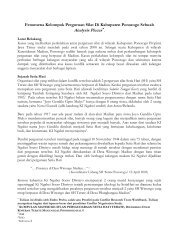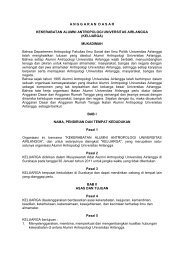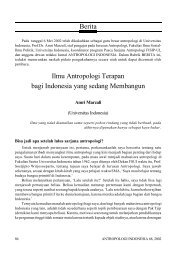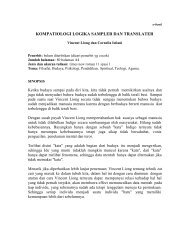The Future of Visual Anthropology: Engaging the Senses
The Future of Visual Anthropology: Engaging the Senses
The Future of Visual Anthropology: Engaging the Senses
You also want an ePaper? Increase the reach of your titles
YUMPU automatically turns print PDFs into web optimized ePapers that Google loves.
widijanto judono e-Library collection - widijanto.wordpress.com<br />
upon which our assumptions are made is also compatible with an applied anthropology.<br />
As we see in chapter 5’s focus on applied visual anthropology, <strong>the</strong> principles<br />
<strong>of</strong> reflexivity and collaboration and <strong>the</strong> process <strong>of</strong> undermining essential truths in<br />
favour <strong>of</strong> understanding individual locations are also integral to applied practice,<br />
and in fact applied and academic visual anthropology share many principles.<br />
Throughout <strong>the</strong> twentieth century <strong>the</strong> strands <strong>of</strong> visual, sensory and applied anthropology<br />
were variously incorporated and rejected as anthropology moved from its ‘multimedia’<br />
practices <strong>of</strong> <strong>the</strong> late nineteenth century to establish itself as a monomedia<br />
academic ‘discipline <strong>of</strong> words’, as Mead (1975) put it. By <strong>the</strong> end <strong>of</strong> <strong>the</strong> twentieth<br />
century <strong>the</strong> bastions <strong>of</strong> scientific anthropology were crumbling in favour <strong>of</strong> a subjective<br />
and reflexive approach that favoured experimentation, welcomed new technologies<br />
and was increasingly recognising its relevance in <strong>the</strong> wider world. In <strong>the</strong> following<br />
sections I suggest <strong>the</strong> meaning <strong>of</strong> this for a visual anthropology for <strong>the</strong> twenty-first<br />
century and outline <strong>the</strong> programme <strong>of</strong> analysis it sets in <strong>the</strong> following chapters.<br />
A visual anthropology for <strong>the</strong> twenty-first century:<br />
opportunities and challenges<br />
<strong>Engaging</strong> <strong>the</strong> visual 15<br />
<strong>The</strong> contemporary interdisciplinary context<br />
Between 1999 and 2001 a series <strong>of</strong> new publications across <strong>the</strong> social sciences and<br />
humanities revealed a thriving interdisciplinary interest in visual research<br />
methods. 26 In chapter 2 I outline this interdisciplinary context, which is at times<br />
plagued with amateur borrowings and misguided critiques (see also Pauwels 2000:<br />
12–13). Some recent publications on visual methods have (misguidedly) set out to<br />
discredit contemporary visual anthropology through criticism <strong>of</strong> its colonial roots<br />
and <strong>the</strong> observational projects <strong>of</strong> its mid-twentieth-century past (for example<br />
Emmison and Smith 2000; Holliday 2001). However, visual anthropologists have<br />
also set about defining a visual research methodology with a basis in anthropology<br />
(Banks 2001; Pink 2001a). In this situation visual anthropology needs to assert its<br />
identity beyond that which is <strong>of</strong>ten attributed to it by virtue <strong>of</strong> its association with<br />
colonial photography and ethnographic film. It needs to ensure that its approaches<br />
and range are understood amongst <strong>the</strong>se emergent visual subdisciplines, each <strong>of</strong><br />
which appears to have academics keen to stake <strong>the</strong>ir claim to be <strong>the</strong> leader in visual<br />
methodology. Simultaneously this surge <strong>of</strong> interest in visual methodologies is good<br />
news: visual anthropology no longer exists in a space where its very focus on <strong>the</strong><br />
visual is a contested project, but in a context where it is <strong>of</strong> interest to both anthropologists<br />
and o<strong>the</strong>r social scientists. Indeed, resistance to <strong>the</strong> visual in anthropology<br />
is now a problem <strong>of</strong> <strong>the</strong> past. This <strong>the</strong>me and <strong>the</strong> interdisciplinary agendas it<br />
involves are taken up in chapter 2, where I identify <strong>the</strong> place <strong>of</strong> visual anthropology<br />
in this emergent interdisciplinary context. I return to this context in chapter 5 to<br />
discuss applied visual anthropology practice, which <strong>of</strong>ten involves working with<br />
colleagues (and principles) from o<strong>the</strong>r disciplines and in chapter 6 to situate visual<br />
anthropological uses <strong>of</strong> hypermedia with o<strong>the</strong>rs across <strong>the</strong> social sciences and










